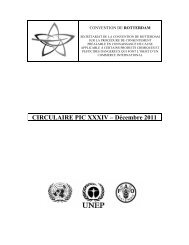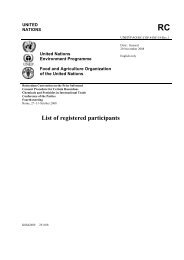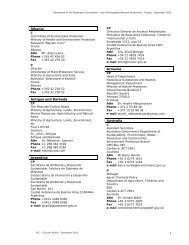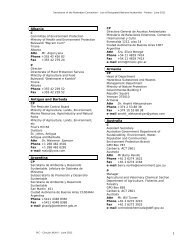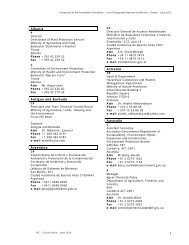RC - What is RC? - Rotterdam Convention
RC - What is RC? - Rotterdam Convention
RC - What is RC? - Rotterdam Convention
You also want an ePaper? Increase the reach of your titles
YUMPU automatically turns print PDFs into web optimized ePapers that Google loves.
outdoors. Th<strong>is</strong> relatively short d<strong>is</strong>appearance time was possibly due<br />
to heterogeneous reactions on the vessel walls, as suggested by the<br />
authors of the report. Hydrogen chloride was found to be the main<br />
degradation product after exposure of samples to xenon arc<br />
radiations (wavelength > 290 nm) (Pearson & McConnell, 1975).<br />
4.2.3 Hydrolys<strong>is</strong><br />
Hexachlorobutadiene <strong>is</strong> highly res<strong>is</strong>tant to chemical<br />
degradation<br />
by strong acids and alkal<strong>is</strong> in the absence of appropriate solvents,<br />
although it <strong>is</strong> readily degraded by ethanolic alkali (Roedig &<br />
Bernemann, 1956). Based on the measured hydrolys<strong>is</strong> rate of the<br />
compound in a 1:1 acetone-water mixture, a half-life of over 1800 h<br />
was calculated (Hermens et al., 1985).<br />
was<br />
and<br />
4.3 Biodegradation<br />
Hexachlorobutadiene, at concentrations of 5 or 10 mg/litre,<br />
completely degraded by adapted aerobic microorgan<strong>is</strong>ms within 7 days<br />
in a static-culture flask screening procedure at 25 °C, as shown by<br />
gas chromatography and by determination of total and d<strong>is</strong>solved<br />
organic carbon. The inoculum was taken from settled domestic waste<br />
water (Tabak et al., 1981). Approximately 70% adsorption to sludge<br />
and 10% degradation was found to occur within 8 days in a pilot<br />
low-loaded biological sewage treatment plant (Schröder, 1987).<br />
Anaerobic degradation of hexachlorobutadiene at 100 mg/litre<br />
was not observed in 48-h batch assays at 37 °C using an inoculum<br />
from a laboratory digester (Johnson & Young, 1983).<br />
4.4 Bioaccumulation<br />
Considering the low water solubility of 3.2 mg/litre and the<br />
high log Kow of 4.78-4.90 (Table 1), a strong bioaccumulating<br />
potential would be expected. Both laboratory and field data support<br />
th<strong>is</strong> prediction. In flow-through laboratory tests with algae,<br />
crustaceans, molluscs and f<strong>is</strong>h in fresh or marine waters,<br />
bioconcentration factors (on a wet weight bas<strong>is</strong>) were between 71<br />
17 000. The results appear to be highly dependent on the exposure<br />
period and there <strong>is</strong> great variability between organ<strong>is</strong>ms (Leeuwangh<br />
et al., 1975; Pearson & McConnell, 1975; Laseter et al., 1976;<br />
Oliver & Niimi, 1983). Steady state was clearly demonstrated to be<br />
reached in only one of these tests. Oliver & Niimi (1983) exposed<br />
rainbow trout (Salmo gairdnerii) to aqueous solutions of<br />
hexachlorobutadiene at 0.10 and 3.4 ng/litre and found average<br />
bioconcentration factors of 5800 and 17 000, steady states having<br />
been reached after 69 and 7 days, respectively. When Oligochaete<br />
worms were exposed via spiked Lake Ontario sediments to a pore<br />
water<br />
concentration of 32 ng/litre in a flow-through system, steady state<br />
was reached within 4 to 11 days and the average bioconcentration<br />
factor was 29 000, based on dry weight of which about 8% <strong>is</strong> lipid<br />
(Oliver, 1987). Biomagnifi-cation, the concentrating of a substance



